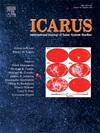Examining the role of water in Martian lowland gully formation
IF 2.5
2区 物理与天体物理
Q2 ASTRONOMY & ASTROPHYSICS
引用次数: 0
Abstract
A variety of processes have been proposed to form Martian gullies with little consensus reached. Detailed mapping combined with morphological and morphometric studies for gully and channel systems on Earth can distinguish these processes from one another, as well as measure the degree to which gullies are formed by liquid water. These parameters include tributary stream orders and magnitudes; drainage densities; channel profile concavities; gully cross-sectional profiles; sinuosity; gully, apex, and apron slopes; and gully/apron volumes.
We applied these morphometrics, detailed gully mapping, and morphologic studies to four gullied craters in the Northern Lowlands of Mars. Morphometric parameters indicate that their morphology is most consistent with a fluvial origin, especially in craters at 63 N, 53 N and 48 N latitude. The gullies in these craters have many first-order tributaries contributing to high tributary stream orders up to 4 and magnitudes ranging from 10 to 65, drainage densities ranging from 8 to 60 km/km2, and concave channel profiles with concavity indices between 0.102 and 0.185. These gullies also form on shallow slopes between 8 and 20 degrees, below the angle of kinetic friction (21 degrees), which indicates fluid emplacement of materials. Gullies in a crater located at 60 N latitude and on the west wall of the 53 N Crater are more poorly developed, with lower tributary integration reflected in the stream magnitude and stream order values (ranging from 2 to 3 and 28 respectively), straight channels, and lower concavity values <0.1 indicating a smaller contribution of water to their formation. Morphological characteristics within the gully systems analyzed in this study, such as multiple apron formation, cross-cutting features, and subsequent deposition indicate that gully formation was episodic. Reduced channel sinuosity and smaller deposits imply that gully activity experienced less water availability over time as conditions within the craters became less suitable for liquid water. A source of water that is compatible with the observed morphologies would be basal melt from dusty snowpacks. These snowpacks might have been deposited at higher obliquity or formed from the cold-trapping of steam freed from the subsurface by impact and the resulting post-impact hydrothermal system.
研究水在火星低地沟壑形成中的作用
人们提出了形成火星沟壑的各种过程,但几乎没有达成共识。结合地球上沟壑和沟渠系统的形态学和形态计量学研究,可以将这些过程彼此区分开来,也可以测量沟壑由液态水形成的程度。这些参数包括支流的顺序和量级;排水密度;沟道轮廓凹陷;沟壑剖面;弯曲;沟壑,先端和围裙斜坡;和沟壑/围裙卷。我们将这些形态计量学、详细的沟壑测绘和形态研究应用于火星北部低地的四个沟壑陨石坑。形态测量参数表明,它们的形态与河流起源最为一致,特别是在北纬63、53和48北纬的陨石坑。这些陨石坑的沟壑中有许多一级支流,支流级最高可达4级,震级在10 ~ 65级之间,流域密度在8 ~ 60 km/km2之间,沟道呈凹形,凹度指数在0.102 ~ 0.185之间。这些沟壑也形成在8到20度的浅斜坡上,低于动摩擦角(21度),这表明物质的流体放置。位于北纬60°和北纬53°的环形山西壁上的沟槽发育较差,支流整合程度较低,表现为流级和流阶值(分别为2 ~ 3和28),河道较为笔直,凹度< 0.1,说明水对其形成的贡献较小。本研究分析的沟壑系统内的形态特征,如多围裙形成、横切特征和随后的沉积,表明沟壑形成是幕式的。河道弯曲度的减小和沉积物的减小意味着随着时间的推移,沟壑活动经历了更少的水可用性,因为陨石坑内的条件变得不适合液态水。与所观察到的形态相一致的水源可能是来自尘土飞扬的积雪的基底融水。这些积雪可能是在更高的倾角上沉积的,或者是由撞击释放的地下蒸汽的冷捕和撞击后的热液系统形成的。
本文章由计算机程序翻译,如有差异,请以英文原文为准。
求助全文
约1分钟内获得全文
求助全文
来源期刊

Icarus
地学天文-天文与天体物理
CiteScore
6.30
自引率
18.80%
发文量
356
审稿时长
2-4 weeks
期刊介绍:
Icarus is devoted to the publication of original contributions in the field of Solar System studies. Manuscripts reporting the results of new research - observational, experimental, or theoretical - concerning the astronomy, geology, meteorology, physics, chemistry, biology, and other scientific aspects of our Solar System or extrasolar systems are welcome. The journal generally does not publish papers devoted exclusively to the Sun, the Earth, celestial mechanics, meteoritics, or astrophysics. Icarus does not publish papers that provide "improved" versions of Bode''s law, or other numerical relations, without a sound physical basis. Icarus does not publish meeting announcements or general notices. Reviews, historical papers, and manuscripts describing spacecraft instrumentation may be considered, but only with prior approval of the editor. An entire issue of the journal is occasionally devoted to a single subject, usually arising from a conference on the same topic. The language of publication is English. American or British usage is accepted, but not a mixture of these.
 求助内容:
求助内容: 应助结果提醒方式:
应助结果提醒方式:


